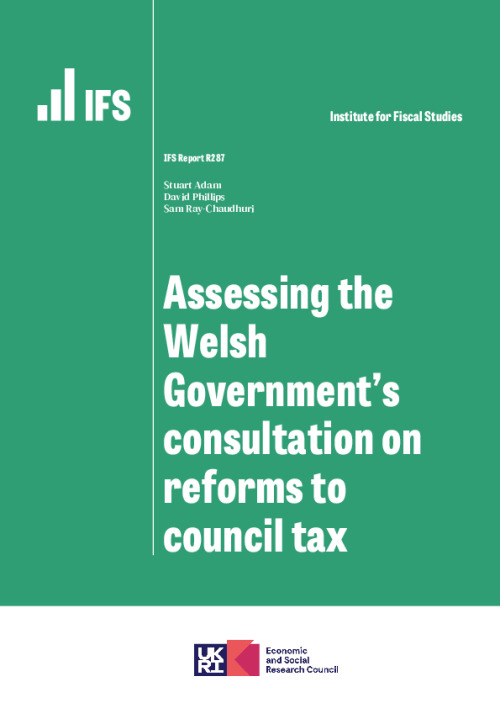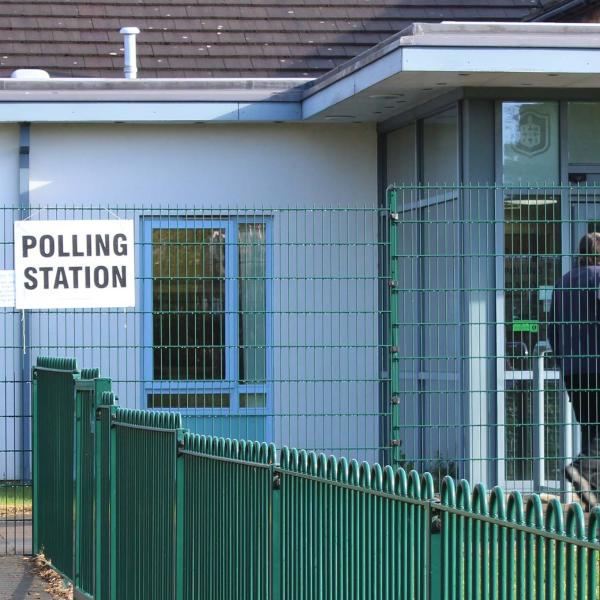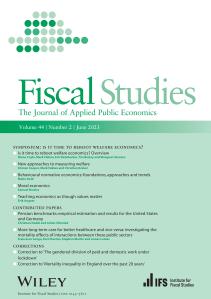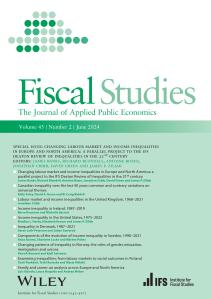Executive summary
The Welsh Government is consulting on a range of possible approaches to council tax reform, some of which would represent the most radical reforms to council tax anywhere in the UK since this tax was introduced in 1993. The bar is pretty low, though. The English system is virtually unchanged from the initial system put in place. The Scottish system has seen modest increases in the relative tax rates applied to properties in Bands E to H, but like in England, bands are still based on 1991 values. The Welsh Government is the only one to have revalued properties before – in 2005, based on 2003 values – when it also introduced an additional band (Band I) for the most valuable 0.4% of properties but otherwise left the structure of the tax unchanged.
The Welsh Government’s consultation document provides three examples of possible reforms – although it notes that the choices are infinite. The first example is a simple revaluation, placing properties into bands based on up-to-date values and updated band thresholds set so that the same fraction of properties across Wales as a whole are in each band as now. The second and third examples go further by reducing the tax rates applied to low-value properties and increasing them on high-value properties to make the tax less regressive with respect to property value than is currently the case, and potentially adding up to three new tax bands. Planned legislation would also put in place provisions for regular revaluations in future, initially every five years.
This report analyses and appraises the possible approaches to council tax reform that the Welsh Government is consulting on, and compares them with a system where the tax rate applied to each band is proportional to the value of properties in that band – which is a useful benchmark to consider to what extent the reforms would address the regressivity of the existing council tax system. It also briefly describes the role the Institute for Fiscal Studies (IFS) has played in helping the Welsh Government model the impacts of different scenarios as it has developed its consultation.
It has been clear from the lack of any revaluation in both England and Scotland that change to council tax is politically difficult. Whatever our views about the ‘ideal’ system, we welcome the fact that the Welsh Government has felt able to work openly with us and others on developing the analytical basis for reform, and is consulting on a range of reform approaches that would improve the current system – some more than others. Governments in Westminster and Holyrood could learn a lot from this example.
The Welsh Government’s consultation
Council tax in Wales is forecast to raise about £2.1 billion in net revenue in 2023–24, an average of just over £1,400 for each of the 1.5 million households in Wales.
Properties in Wales are currently placed into one of nine bands (A to I) for council tax purposes, with the Welsh Government setting the relative tax rates for different bands, and local councils (and police authorities) determining the overall level of council tax in each area by setting the tax rate for a Band D property. There is a range of discounts and premiums for different kinds of households/properties, the biggest of which (a 25% discount for one-adult households and a means-tested council tax reduction scheme, CTRS) are Wales-wide schemes but some of which are at local discretion.
Council tax bands in Wales are based on property values in April 2003 – 20 years ago. That is more up to date than in England and Scotland, where they are based on values in April 1991. But it is still enough time for the relative values of different properties to change significantly. For example, the Office for National Statistics’ House Price Index implies that average property values increased by over 270% between April 2003 and April 2023 in Blaenau Gwent and Merthyr Tydfil, but by less than 135% in Conwy, Flintshire and Wrexham over the same period.
Moreover, while the difference in (2003) values between a property in Band A and a property in Band I is at least 9.5-fold, the difference in tax bills is just 3.5-fold. Council tax is therefore both increasingly out of date and arbitrary, and highly regressive with respect to property values. In other words, it is ripe for revaluation and reform.
Following on from a previous consultation on the broader principles for reform, the Welsh Government’s new consultation document sets out three possible approaches:
- Minimal reform: a pure revaluation, where properties would be placed into one of nine bands based on estimates of their up-to-date values, and where band thresholds would be updated so that the same fraction of properties would be in each of the nine bands as now across Wales as a whole.
- Modest reform: a less regressive, revalued 9-band system, where in addition to the steps taken in (1), the tax rates applied to Bands A to C would be reduced relative to the Band D rate, and those applied to Bands E to I would be increased.
- Expanded reform: a less regressive, revalued 12-band system, where properties would be placed into one of 12 new bands based on estimated up-to-date values, and where there would be one additional band at the bottom (A1) and two additional bands at the top (J and K) of the value distribution, with Bands A1 to C facing lower relative tax rates and Bands E to K facing higher relative tax rates than presently.
The Welsh Government’s consultation document sets out illustrative tax bands for each of these approaches, based on the initial estimates by the Valuation Office Agency (VOA) of property values as of April 2023. The consultation document does not provide information on the relative tax rates that would be applied to these different tax bands, reflecting the fact that the Welsh Government is seeking the widest possible views on the scale of reform that should be undertaken. In order to model the quantitative effects of the different approaches, the IFS worked with the Welsh Government to help identify a set of illustrative example tax rates for each tax band for the three approaches, which we use in this report. The rates and thresholds used in any eventual reform, however, may differ from the examples analysed here.
The ‘minimal’ reform (a pure revaluation) would bring council tax up to date, so that the bill for a property reflected its current value rather than its value 20 years ago; but on its own it would do little to reduce the regressivity of the system. The example ‘modest’ and (especially) ‘expanded’ reforms would somewhat reduce the regressivity of the system. But both would still be some way short of making council tax liabilities proportional to property value (a benchmark against which we compare the different example reforms).
A revaluation would reduce bills for properties which have seen their value increase by less than average over the last 20 years, and increase them for properties which have seen their value increase by more than average. The potential reforms to make it less regressive would reduce bills for low-value properties and increase them for high-value properties.
The impact on bills, though, would also depend crucially on how Welsh councils respond to the changes in tax bases and grant funding generated by any reforms enacted – and, in particular, on the Band D council tax rates that they set. The Welsh Government intends the reforms to be revenue-neutral, not a revenue-raising exercise; but that is not within its control, unless it dictates the Band D rates that councils set. While the Welsh Government would not use the revaluation and reform of council tax to change the total grant funding provided to councils, grants would be redistributed among councils in line with the changes in their council tax bases in order to reflect changes in their assessed ability to raise their own revenue through council tax. Councils seeing a change in their grant funding might respond by adjusting their spending on local services or by raising more/less in council tax to offset the change in grant funding. If councils seeing increases and decreases in grant funding respond asymmetrically, overall average bills and therefore aggregate council tax revenue (and spending on local services) may go up or down.
In this report, we assume that councils hold spending on local services fixed – adjusting the council tax they raise to offset changes in grant funding and thus keep their total revenue the same as in the absence of reform – implying that revaluation and reform in themselves would be revenue-neutral across Wales as a whole. As in years without reforms to council tax, though, the overall amount raised from council tax in the year any reform is implemented would likely increase in cash terms as rising costs and demands increase councils’ revenue requirements. Such increases would be likely irrespective of whether revaluation and reform take place.
Impacts on different parts of Wales
1. There are large disparities across Welsh councils in the share of properties in each council tax band – more than 58% of properties in Blaenau Gwent are currently in Band A, compared to just 1% in Monmouthshire. Revaluation based on 2023 property values would not change the fact that there are large disparities across councils, but would reflect how those have changed since 2003.
2. The South Wales Valleys, and rural areas in general, have seen bigger increases in property values than other parts of Wales, and so revaluation (the minimal reform approach) would reduce the number of low-band properties in these areas (although some individual properties would still go down bands). By contrast, Cardiff, Swansea and North East Wales have seen slower growth in property values and so would see more properties in lower bands (although some individual properties would still go up bands).
3. Assuming that grant funding were redistributed in line with the changes in tax bases implied by these band movements, and councils set their tax rates so that their total funding (from council tax and grants) were the same as in the absence of reform, under a pure revaluation (the minimal reform approach), changes in average bills would mirror the pattern of band changes. Average bills would increase in the Valleys (for example, by 6% in Merthyr Tydfil) and many rural areas (by 5% in Gwynedd and the Isle of Anglesey), and fall in Cardiff, Swansea the North East Wales (for example, by 8% in Denbighshire).
4. Changes in bills under a less regressive council tax would depend on the level of property values as well as how they have changed since 2003. For some councils, where property values are high relative to the rest of Wales and have increased a lot since 2003, such as Monmouthshire and the Vale of Glamorgan, both these factors would increase average bills under revalued, less regressive council tax systems. For other areas where values are low and have increased little, such as Denbighshire and Swansea, both factors would reduce average bills. But for areas where values have increased a lot but remain low (such as much of the Valleys), or have increased by less than average but remain high (such as Cardiff), the two factors will work in opposite direction. Whether average bills would increase or decrease in these areas would depend on how much less regressive council tax was made.
5. The example expanded reform, a 12-band system with less regressive tax rates, would see average bills rise most in Monmouthshire (+16%) and the Vale of Glamorgan (+15%) and fall most in Blaenau Gwent (−12%) and Denbighshire (−11%). Average bills would also rise by 5%–7% in Cardiff, Gwynedd, the Isle of Anglesey, Pembrokeshire and Powys, and fall by 5%–9% in Flintshire, Neath Port Talbot, Rhondda Cynon Taf, Swansea and Wrexham. The example modest reform (a 9-band less regressive system) would see a similar pattern of increases and reductions in average bills across councils, albeit with the magnitude of effects being smaller than under the example expanded reform. Both of these systems would mean considerably smaller changes than under the 12-band proportional system, which would see average bills increase by over a quarter in Monmouthshire and the Vale of Glamorgan and fall by over a fifth in Blaenau Gwent.
6. Within councils, there would be different impacts on different neighbourhoods (‘lower super output areas’ or LSOAs). For example, parts of inner-city Cardiff and much of Swansea would see falls of £250–£500 in average annual bills under the example expanded reform, whereas the more expensive suburban areas of Cardiff and western Swansea would see average bills increase by that amount or more. Similarly, while average bills would increase in most parts of predominantly rural counties in mid, north and west Wales, they would decrease in many of the main towns in these counties.
7. In general, more deprived neighbourhoods would see their average bills fall under reforms that reduce the regressivity of the tax rates. More rural (sparsely populated) neighbourhoods would see average bills increase under these reforms as well as under minimal reform, because these areas have higher property values and have seen bigger increases since 2003.
8. The majority of households would see their gross council tax bill (i.e. before any discounts or premiums) fall under reforms that make the council tax system less regressive. Under the example expanded reform, more households would see their gross bill fall than rise for the most deprived seven-tenths of neighbourhoods. And only the most rural tenth of neighbourhoods has more households that would see an increase in their gross bill than a decrease.
Impacts on different household types
9. The data available to us mean that we cannot look at the fraction of households seeing decreases or increases in their net council tax bill (that is, after premiums and discounts, including means-tested support) by council area or neighbourhood, but we can do this for Wales as a whole, and for different household types. Across Wales as a whole, under the minimal reform (pure revaluation), around 60% of households would see their net council tax bill change by less than £50 per year under minimal reform, with roughly equal numbers seeing decreases or increases of more than this amount. Under the expanded reform approach, around 40% of households would benefit from a reduction in their net bill of at least £50, compared to around 28% that would see an increase of at least £50. Having more winners than losers from a revenue-neutral reform is possible because the average increase in annual net bill among those seeing an increase of more than £50 (£442) would be bigger than the average cut in net bill among those seeing a cut of more than £50 (£312).
10. Reforms that reduce the regressivity of council tax with respect to property value are also progressive with respect to household income. The example expanded reform would reduce average net bills by £27 per year (0.16% of household income) for the poorest fifth of households and £90 per year (0.36% of household income) for the next poorest fifth. In contrast, it would increase average net bills for the richest fifth by £174 per year (0.19% of household income). The example modest reform would have qualitatively similar impacts, albeit smaller in magnitude, but a pure revaluation, the minimal reform approach, would have very small impacts across the income distribution, on average.
11. Similarly, a pure revaluation would not have systematic effects across different household types. Less regressive systems would, on average, reduce net bills for younger households, single-adult households, those receiving disability benefits, and renters – although there would be some households among these groups facing increases. Correspondingly, other groups such as older households, couples and owner-occupiers would face an increase in average bills – although there would be many households among these groups seeing a tax cut, particularly those with low-to-middle incomes. Both the example modest and expanded reforms would still be some way short of a proportional system, under which changes in average bills for different types of households would be substantially larger.
12. The majority of low-income households would see very little change in their net bill from revaluation and reform, since their council tax bill is often fully covered by CTRS. Those that do see a significant change are more likely to gain than lose. This includes low-income pensioners and, to a lesser extent, low-income residents of the more expensive parts of Wales.
Impacts on rents and property values
13.The council tax bill for a property will affect how much households are willing to pay to live in it. We would expect council tax reform to lead to increases in market rents for properties whose bills fall, and falls in rent for properties whose bills increase, in effect passing some or all of the gain/loss from tenants to landlords. As a result, the example modest and expanded reforms would be less progressive than analysis of changes in bills alone would suggest since landlords (who would benefit from rent increases) are generally richer than renters (whose council tax bills would be reduced).
14. Counterintuitively, low-income tenants whose council tax bills are partly or wholly covered by CTRS could lose out if the gross council tax bill on their property is reduced. This is because they would not benefit from the bill reduction themselves (because their CTRS entitlement would change pound-for-pound) but could see their rent increased (because other potential renters of the property, not on CTRS, would be willing to pay more given the lower council tax bill). Discretionary housing payments could be used on a case-by-case basis to provide support to households on CTRS seeing big increases in rent following reductions in the gross council tax bill due on their property.
15. In a similar manner to rents, revaluation and reform will almost certainly affect property prices: a rise (fall) in council tax bill reduces (increases) the amount potential buyers would be willing to pay for a property. The extent to which property values are affected depends on how households value future tax payments.
16. It is important to emphasise that changes in property values resulting from revaluation and reform do not represent a ‘double effect’, whereby a household would lose twice over, from both higher council tax bills and a fall in property value. Rather, such a household would pay higher council tax while they continued to live in the property, and suffer from the fall in property value only when they sold it, reflecting the higher council tax that the future owners would have to pay – but that they no longer would. This does mean, though, that it is the current owners of properties that are set to bear most of the long-term losses or gains if the tax bill on their property is increased or reduced.
17. If households value money in future (relative to money today) in line with expectations of long-term interest rates, and if prices fully adjust in response to changes in council tax bills, the cheapest tenth of properties would see their value increase by 18% on average under the example expanded reform. Conversely, the most expensive tenth would see their value fall by 5%. This is in the context of increases in values of around 33% since prior to the COVID-19 pandemic.
18. The minimal reform approach, a pure revaluation, would have only small effects on average property values by council. The example expanded reform would increase average values in Denbighshire by around £8,600 (4%) and decrease average values in Monmouthshire by around £15,900 (4%) if prices fully adjusted to reflect changes in bills, and our baseline assumptions about how households value the future. Again, these are in the context of much larger increases in value over the last few years.
19. Low-income owner-occupiers would see their property values rise on average under reforms that reduce the regressivity of the council tax system. For the example expanded reform, values would rise by 1.5% for those in the poorest income quintile. Those in the richest quintile would see average property values fall by 2.6%. Revaluation and reform of council tax could therefore contribute to reductions in wealth inequality both across places and across households.
Our overall appraisal
The Welsh Government’s proposed direction of reform is very welcome.
Council tax revaluation is unambiguously a good idea, and legislating for regular revaluations in future is even better. It is indefensible to continue to tax people based on the value of their property more than 20 years ago, and setting out firm plans for future revaluations would not only help to prevent council tax from getting so out of date again, it would also reduce the risk of people being surprised by unexpected future revaluations and changes in bills.
The appropriate degree of progressivity in the tax system is a political choice. But a stated aim for reform is to make council tax more progressive (or, at least, less regressive). The expanded approach would fulfil that aim better than the others suggested in the consultation document, though it would still fall short of making tax bills proportional to property value – perhaps too big a change for the Welsh Government to want to introduce in one giant leap.
Adding more bands would allow for a more fine-grained relationship between property value and tax liability, a helpful improvement. Ideally, the Welsh Government would go further and move away from a banded system altogether, levying the tax as a percentage of an exact property valuation, as many other jurisdictions (including Northern Ireland) do. We are not well placed to judge whether the Welsh Government’s argument for sticking with relatively wide bands – that it would minimise challenges associated with valuation – is a good one. However, we note that when it comes to appeals, in principle the effect is ambiguous, as giving properties more precise valuations might leave more people believing their valuation was wrong but would also mean generally smaller changes in bills if an appeal was successful, reducing the incentive to appeal.
A banded system also creates unfairness between households just either side of the thresholds, who have very similar property values but must pay very different amounts of tax. With a given number of bands, making the tax rates less regressive would actually exacerbate this particular unfairness, as the jump in tax bills at thresholds would be bigger. It can be alleviated by having more, narrower bands, so that the jump in liabilities at any one threshold is smaller – or again, ideally by moving from a banded to a continuous system.
A separate review of council tax discounts is ongoing, but the consultation document says that the Welsh Government intends ‘to retain the one-adult discount and to keep the level of discount at 25%’. Keeping the current structure of the discount would be unfortunate. Since the cash value of the discount is higher for properties in higher bands, it encourages inefficient use of the housing stock, with single-adult households living in bigger properties, and multi-adult households living in smaller properties, than they otherwise would – contributing to both under-occupation and overcrowding. If the Welsh Government wants to continue providing a one-adult discount of similar overall generosity to the current one, it would be better to reform it so that the size of the discount did not depend on the value of the property: setting the discount equal to, say, 40% of the Band A rate (or 20% of the Band D rate, or similar), regardless of what band the claimant’s property is actually in. Such a change would also go further towards making council tax less regressive, increasing the generosity of the discount for those in low-value properties and reducing it for those in high-value properties.
Notwithstanding any minor quibbles, the direction of reform set out in the consultation document is a good one. It is only a pity that the consultation document opens up the prospect of potential delay from the previously stated intention of implementing revaluation and reform in 2025, creating more uncertainty for households and councils. There is no obvious advantage to delay (as opposed to having a gradual transition for households seeing large changes in bills, for which there is a case). Reform is politically challenging, as it creates losers as well as winners, but delay would not make it any easier. Both Labour and Plaid Cymru committed to reforming council tax in their 2021 election manifestos, and that shared commitment was repeated in the Co-operation Agreement between them; it is hard to imagine more propitious circumstances in which to proceed. The Welsh Government should go ahead with revaluation and reform in 2025 as originally planned – and the UK and Scottish governments should follow suit.












